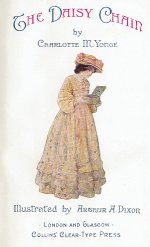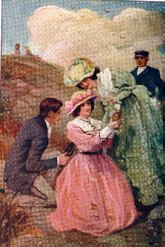|
Click
here to reach the latest online version of
from Gutenberg
(Many thanks to Sandra Laythorpe and others)
Virago edition of The
Daisy Chain
Virago published an edition of The
Daisy Chain in 1988 in their Virago modern classics series.
This edition had a new introduction by Barbara Dennis and a new afterword
by Georgina Battiscombe.
The Virago edition ISBN 0860688798
is no longer in print.
For a commentary on death in childhood, including comments on The Daisy
Chain, see the page 3 of on The Victorian Web.
(This material is excerpted with permission of the publisher from Chapter
4 of Through the Northern Gate: Childhood and Growing Up in British
Fiction, 1719-1901, by Jacqueline Banerjee [New York: Peter Lang,
1996].
'No one can be more sensible than is the
Author that the present is an overgrown book of a nondescript class, neither
the "tale" for the young, nor the novel for their elders, but
a mixture of both.
Begun
as a series of conversational sketches, the
story outran both the original intention and
the limits of the periodical in which it was
commenced; and, such as it has become, it
is here presented to those who have already
made acquaintance with the May family, and
may be willing to see more of them. It would
beg to be considered merely as what it calls
itself, a Family Chronicle - a domestic record
of home events, large and small, dining those
years of early life when the character is
chiefly formed, and as an endeavour to trace
the effects of those aspirations which are
a part of every youthful nature. That the
young should take one hint, to think whether
their hopes and upward-breathings are truly
upwards, and founded in lowliness, may be
called the moral of the tale.
For those who may deem the story too long,
and the characters too numerous, the Author can only beg their pardon
for any tedium that they may have undergone before giving it up.'
Feb.
22nd, 1856
Given
at
Text & Architecture – An
international Word & Image Conference, Paris, 26-28 June 2003
This paper 'reads' Victorian
Gothic domestic architecture alongside the English nineteenth-century
domestic novel in order to articulate common themes and structures in
these contemporaneous representational forms. Using photographs, plans,
and other visual materials as well as literary texts, the paper focuses
on the mid-Victorian commitment to purifying domestic representational
forms (novels and houses) through a sacralization of both verbal and non-verbal
structures of meaning.
The paper takes as the first
of its two central 'texts' Tyntesfield House, near Bristol in England.
The self-made millionaire, and Oxford Movement Christian, William Gibbs
bought a Georgian manor house which he commissioned a local architect,
Norton, to redesign, enlarge, and glorify (1863–6). After Gibbs's
death, his son commissioned further alterations (Woodyer, 1885–9)
which consolidated the building's whole-hearted Gothicism. The result
was Tyntesfield House, a spectacular 43-bedroom Victorian Gothic mansion,
which remained in the ownership of the Gibbs family until 2002.
In relation to ecclesiastic
architecture, George L. Hersey has analyzed High Victorian Gothic as an
eloquent medium of missionary Christianity whose roots lie in nineteenth-century
associationism, a theory of design which held that buildings should 'express'
their function through contrasting volumes, masses, and distribution of
detail; the central 'message' of Victorian Gothic churches, Hersey argues,
is one of didactic torment, 'offer[ing] to the observer the prospect of
his own suffering for Christ'.
This paper uses a comparable
semiotic approach to propose that the expressive function of domestic
Gothic may be understood as a religious purification of family life. The
most extraordinary – yet archetypal – feature of Tyntesfield
is the enormous private chapel (by Arthur Blomfield), fully integrated
into the main body of the house and thus expressing at the level of architectural
structure the cultural project of sacralizing the domestic sphere. Blomfield
later completed a consonant commission in the design of Selwyn College,
Cambridge, whose Master's Lodge (1883) similarly effects domestic comfort
within an ecclesiastic architectural idiom. Tyntesfield House may thus
be analyzed as an architectural text whose physical structures narrate
an authoritative Victorian story about the relations between material,
domestic experience and the redemptive realm of Oxford Movement Christianity.
In the sphere of literary
production, the most prolific and popular exponent of this mid-Victorian
missionary Christianity was Charlotte Mary Yonge (1823–1901), a close
friend of the Gibbs family, and frequent visitor to Tyntesfield. Yonge's
bestselling novel The Daisy Chain (1856) forms the second major focus
of the paper.
The paper argues that The
Daisy Chain may be seen as the literary counterpart to Tyntesfield House,
in that its expressive and didactic project is a cognate purification
of domestic narrative through the sacralizing cadences of religious discourse.
The novel begins with a happy family of eleven children, and proceeds
to dismantle this extravagantly procreative nucleus by a series of disasters
and sacrifices whose effect is to break up domestic and sexual relations
and replace them with missionary work at home and abroad; the plot culminates
in the consecration of a new church, and the almost total imposition of
celibacy on its protagonists. Like a Gothic church, The Daisy Chain functions
as a purifying medium, a machine à souffrir for characters and
readers alike, participating in a Victorian literary tradition of the
house as torture appliance that stretches from Charlotte Brontë's
Jane Eyre (1847) to Henry James's The Spoils of Poynton (1897). Yonge's
characters shift at moments of high drama into fluent biblicalese, an
effect which echoes at sentence-level the novel's symbolic and structural
commitments to a sacralization of secular discourse clearly akin to the
semiotic project of Victorian Gothic domestic architecture.
Website note:
Tyntesfield House was
recently bought by the National Trust and is open to limited public access.
For current details see the .
For another article on Tyntesfield
see by Lyle Eveillé of CMYF.
The Charity
Bazaar and Women's Professionalization in Charlotte Mary Yonge's The
Daisy Chain (2007)
Thorne-Murphy, Leslee
"The Charity Bazaar and Women's Professionalization in Charlotte
Mary Yonge's The Daisy Chain"
SEL Studies in English Literature 1500-1900 - Volume 47, Number 4, Autumn
2007, pp. 881-899
Extract from
abstract: As an established author musing on the changes in women?s
professionalization that had occurred during her lifetime, Charlotte
Mary Yonge remarked that women's involvement in bazaars had changed
the way her society thought about women earning money. By examining
the depiction of a charity bazaar in The Daisy Chain, we see how she
used the methods and logic of the charity bazaar to represent her own
participation in the publishing marketplace. In 1877, as an established
novelist, Charlotte Mary Yonge reflected on a change that had happened
during the course of her career. As a child, she had understood that
a lady did not accept payment for her work, yet just thirty years later,
she observed, "everybody does want to make money." She mused,
"I suppose the bazaar system first led to the change of tone."
In typical understated fashion, Yonge pinpointed a seemingly minor element
of Victorian life that, according to her observations, had fundamentally
changed society's attitude toward women earning money: "the bazaar
system."
The Daisy Chain in E. Nesbit’s The Wouldbegoods
(1901)
.... This took our breath away and we went home.
As we went, Oswald, who notices many things that would pass unobserved
by the light and careless, saw Denny frowning hard. So he said, ‘What’s
up?’ …
‘Well, then, do you know a book called The Daisy Chain?’
We didn’t.
‘It’s by Miss Charlotte M. Yonge,’ Daisy interrupted, ‘and
it’s about a family of poor motherless children who tried so hard
to be good, and they were confirmed, and had a bazaar, and went to church
at the Minster, and one of them got married and wore black watered silk
and silver ornaments. So her baby died, and then she was sorry she had
not been a good mother to it. And – ‘ Here Dicky got up and
said he’d got some snares to attend to, and he’d receive a report
of the Council after it was over. But he only got as far as the trap-door,
and then Oswald, the fleet of foot, closed with him, and they rolled together
on the floor, while all the others called out ‘Come back! Come back!’
like guinea-hens on a fence.
Through the rustle and bustle and hustle of the struggle with Dicky, Oswald
heard the voice of Denny murmuring one of his everlasting quotations -
‘”Come back, come back!” he cried in Greek,
“Across the stormy water,
And I’ll forgive your Highland cheek,
My daughter, O my daughter!”‘
When quiet was restored and Dicky had agreed to go through with the Council,
Denny said –
‘The Daisy Chain is not a bit like that really. It’s a ripping
book. One of the boys dresses up like a lady and comes to call, and another
tries to hit his little sister with a hoe. It’s jolly fine, I tell
you.’
Denny is learning to say what he thinks, just like other boys. He would
never have learnt such words as ‘ripping’ and ‘jolly fine’
while under the auntal tyranny. Since then I have read The Daisy Chain.
It is a first-rate book for girls and little boys.
|

